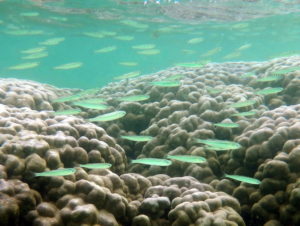
During a recent swim, I found myself suddenly surrounded by a school of baby fish. I don’t know what species they are, but I have this picture for future ID. ©Susan Scott
July 29, 2021
When snorkelers and beach goers describe a marine animal to me, and ask for identification, I tell them, “Next time, get a photo. Even if it’s blurry or cloudy, a picture is the only way to be sure of what you saw.”
Last week, I nearly failed in my own advice when I arrived at the beach for my morning swim, and discovered I’d forgotten my camera. In my defense, my hands are full when I head to the water. Besides mask, snorkel and fins, I carry Sea Drops to keep my mask from fogging, and a key to get back in the house. In addition, I bring a knife to rescue turtles from the discarded fishing gear I find every day on my North Shore reef. When I’m not using the knife to free turtles directly, I’m cutting monofilament off coral heads and rocks, and stowing line, sinkers and hooks in the net bag that I also carry. Oh, and after having fingers poked and clothes torn, I keep a cork in the bag in which to stick the hooks.
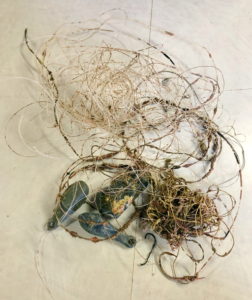
Anyway, last Saturday when I dropped my gear on the ground and found that my camera wasn’t there, I almost went snorkeling without it. I’m so happy I changed my mind, though, because I can now share that extraordinary morning swim.
After only a minute in the water, a fireworm showed up. Fireworms are plentiful in Hawaii, but I rarely see these formidable meat-eaters that cruise the reef eating crabs, shrimp, starfish, snails, other worms, seaweed, and anything dead or dying. As if that’s not impressive enough for a worm, the well-named fireworms have sharp, poisonous bristles along their edges that can break off in human skin and cause a painful rash.
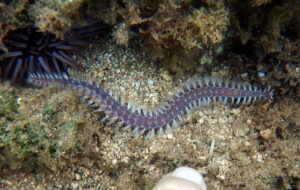
Hawaii hosts are least six species of fireworms, growing 6-to-8 inches long. I don’t know which this is. Hawaiians called all fireworms ‘aha huluhulu, meaning “hairy cord.” ©Susan Scott
I watched the fireworm hunt until it disappeared under a coral head. And what an eye-popping coral head it was. That one cauliflower coral, about the size of a real cauliflower plant, was an entire condominium complex. I saw, in one small area, four different kinds of animals, and after downloading the pictures, five.
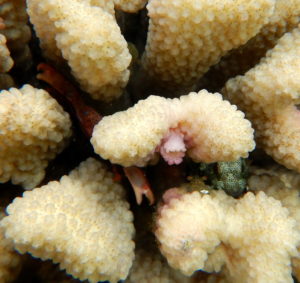
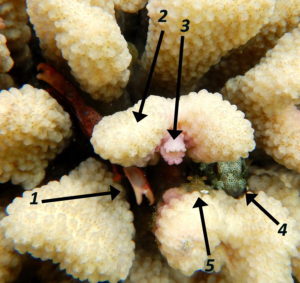
1) Guard crab or Trapezia intermedia, 2) Cauliflower coral or Pocillopora meandrina, 3) Gall crab or Hapalocarcinus marsupialis, 4) Speckled scorpionfish or Sebastapistes coniorta, 5) Flattened coral shrimp or Harpiliopsis depressa.
Another cauliflower coral head a few yards away sheltered a school of adorable baby Hawaiian damselfish.
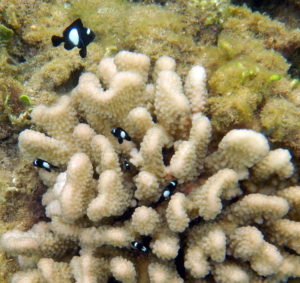
Hawaiian Dascyllus, AKA Hawaiian domino damselfish. (Dascyllus albisella.) The Hawaiian name, ‘ālo’ilo’i means bright and sparkling. Only the tiny young ones have the light blue third spot on their foreheads. ©Susan Scott
Next, I stopped to admire a turtle whose half-lidded eyes and limp flippers made the creature look blissful over the massage it was getting by several convict tangs. Fish picking parasites and algae from the shells and soft skin of turtles is a fairly common sight at Hawaii’s so-called “cleaning stations.” Our turtles are exceptionally tolerant of letting people watch the spa treatments.
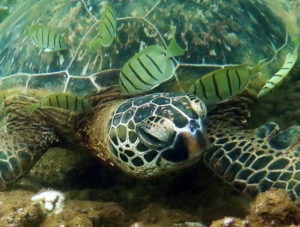
Finally, at the end of my quarter-mile swim, I spotted a banded coral shrimp’s long, white antennae sticking out of a crack on a coral head. I couldn’t see far into the deep crack, but aimed my camera in for a half-blind shot. Later I saw what the little groomer shrimp had likely been doing: removing and eating parasites from a moray eel.
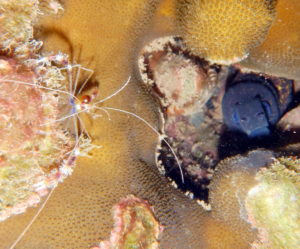
At right is a a yellowmargin moray eel, Gymnothorax flavimarginatus. The banded coral shrimp, Stenopus hispidus, is sometimes called a barber pole or peppermint shrimp. ©Susan Scott
Besides beach goers asking me to identify something they saw in the water or on the beach, they also often ask, when I emerge from the water, “See anything interesting?”
This time, I saw about a dozen things interesting. And fortunately, I have the pictures to prove it.
Kolea Update
Ready or not, here they come. But we Hawaii plover lovers are ready. As of this writing, bird fans have reported 41 Kolea in July, one on the Big Island, the rest on Oahu. Please share these latest count details:
koleacount.org/plover-lovers-make-kolea-count-an-annual-affair/
